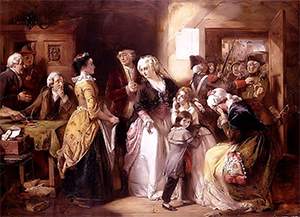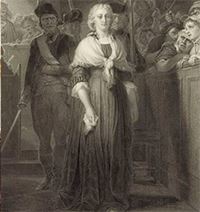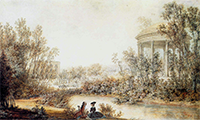Marie Antoinette
Part 2: All Fall Down
She was well-known for enjoying chocolate, a delicacy that most people couldn't afford. She employed her own private chocolatier at Versailles and enjoyed a chocolate drink most mornings. Almost from the beginning, a certain element of French society targeted the queen with slander and libel, speaking untruths and half-truths and writing outright lies about the foreign queen and her high-spending ways. This gave rise to her being dubbed "Madame Deficit" and much worse. The more in debt France became–for a variety of reasons that dated all the way back to the treasury-sapping wars of Louis XIV–the more many of the queen's subjects blamed her for the economic struggles that she, as the monarch's wife, was technically overseeing. 
She was the victim of a plot in 1785 involving a necklace. A certain salesman offered the queen a large necklace at a very high price, and she refused to pay that much. However, one of her enemies, posing as the queen, arranged to buy the necklace anyway and then stole it, telling the seller that the queen was good for the money and that she would pay soon. When the seller hadn't received any money for some time, he sent notes to the queen, who was unaware of the transaction. Finally, the seller was arrested and the conspiracy unmasked. Marie Antoinette played no part in the plot but got the blame in the public eye anyway because people could all too easily believe that she would have coveted such an expensive necklace and might have somehow tried to find the money to pay for it. One of the more outrageous stories that circulated about Marie Antoinette involved her response to a bread shortage. She is said to have remarked that if people had no bread, then "Let them eat cake." The vast majority of historians now think that she never said such a thing; in fact, such a story appeared in the Confessions of Jean-Jacques Rousseau much earlier in Marie's life. Also in fact, the queen was known to have given large amounts of food to people in need and even sold off a number of expensive things in her possession in order to buy grain for the poor. As well, the king proved unwilling or unable to make hard decisions about pressing governmental matters. He aspired to be the kind of absolute monarch that his two predecessors had been, but he possessed a much less iron will than they had and was also not feared as much as they had been. The victim of bad luck as well as bad harvests, the king turned in desperation to the Estates-General in order to sign off on a program of revenue generation. What the king got instead was a series of every more republican legislatures, resulting in a constitutional monarchy that he was forced to accept. 
Things turned violent on several occasions as the 1780s came to a close and the 1790s rolled in. A mob stormed the Bastille on July 14, 1789 and then stormed the royal Tuileries Palace in August 1792, taking the royal family prisoner. In between Marie had convinced her husband to take the family and flee, ostensibly to Austria; they were stopped, at Varennes, near the Austrian border, and returned under armed guard to Paris, where they remained under house arrest. The Legislative Assembly abolished the monarchy on Sept. 21, 1792. A mere four months later, the successor legislature, the National Convention, tried and convicted the king of treason and sentenced him to die. He was killed on Jan. 21, 1793. 
Marie, still in prison, held out hope of being rescued or pardoned or perhaps forgotten. None of those things happened. She herself faced a treason trial beginning on Oct. 14, 1793. She, too, was found guilty and sentenced to death. Execution was her fate, two days later. She was 37. First page > From Princess to Queen > Page 1, 2 |
|
Social Studies for Kids
copyright 2002–2025
David White



 The showcase for the extravagant queen, however, was the Petit Trianon, which
The showcase for the extravagant queen, however, was the Petit Trianon, which 
